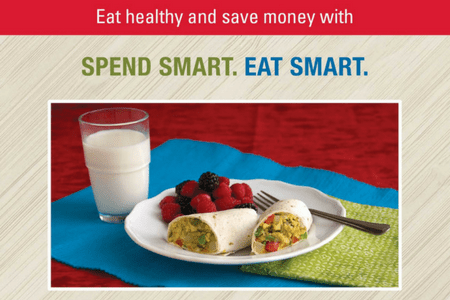WIC food packages and nutrition education are the chief means by which WIC affects the dietary quality and habits of participants. Did you know that these two benefits are among the top reasons for continued participation in WIC (in addition to the work of WIC personnel!), and that consistent 4-year participation in WIC was associated with better diet quality?
Eye on Nutrition (EON) brings focus to the foods and nutrients in the WIC food packages to shine a light on their importance to WIC participants. This EON focuses on calcium – a nutrient of public health concern - and the important role it plays in various life stages from pregnancy to breastfeeding and throughout childhood, as well as for overall health.
Given calcium absorption is dependent on vitamin D – also a nutrient of public health concern – be sure to visit the EON for this nutrient.
Through nutrition education, WIC staff can help participants understand the importance of this vitamin and mineral dynamic duo, and provide calcium-rich recipes (here on WIC Works, and on MyPlate Kitchen) to help participants make the most of their food packages. (You can also use the Yogurt 5 Ways card for creative ideas to use yogurt – select “dairy” under the topic filter on the Print Materials page).
According to the Dietary Guidelines for Americans, 60 percent of women older than age 19 years do not consume enough calcium, and more than 90 percent do not consume enough vitamin D.
What is Calcium and Why is it Important?
What WIC-Eligible Foods Provide Calcium?
Is Calcium on the Nutrition Facts Label?
Education Resources
What is Calcium and Why is it Important?
Calcium is the most abundant mineral in the body, and the majority of it (99%) supports bone structure and function. While only 1% of calcium supports other functions, these are critical metabolic functions, such as:
- Movement of blood through blood vessels
- Muscle function, including regulating normal heart rhythms
- Nerve function and signaling between the brain and body
- Release of hormones and enzymes
Given the roles noted above, it is no surprise that:
- Calcium is important during pregnancy since it helps strengthen the baby’s rapidly developing bones and teeth.
- Calcium helps develop strong, healthy bones and teeth during childhood – a period of rapid growth.
- Body stores of calcium (primarily from bones) supply much of the calcium in breast milk to meet the baby’s calcium needs. After breastfeeding, the body must replenish the calcium that was used to produce milk. Consuming the recommended amount of calcium helps ensure that bones will remain strong after weaning the baby.
Getting adequate calcium can reduce the risk of certain illnesses and conditions, such as:
- Preeclampsia - a serious condition where a pregnant woman develops high blood pressure and high levels of protein in the urine, which affects both mother and fetus (check out our page on this and other hypertensive disorders).
- Lead poisoning - a toxic mineral found in nature, lead mimics essential nutrients (like calcium) and can stay in the body of children and pregnant women for a long time. Eating a diet with enough calcium (and iron) is thought to help protect the body against lead poisoning.
What WIC-Eligible Foods Provide Calcium?
A number of WIC-eligible foods contain calcium, though not all foods may be available in every State, US Territory, or Indian Tribal Organization due to the flexibility they have in selecting foods for their WIC food packages. Among the WIC-eligible foods that provide calcium are:
- Milk products and milk alternatives
- Cow’s and goat’s milk (fluid, shelf-stable, or evaporated)
- Dry, cultured, and acidified milks
- Lactose reduced/lactose free
- Fortified soy beverage
- Cheese
- Yogurt
- Tofu
- Soybeans (edamame)
- Green leafy vegetables, like kale, Chinese cabbage, bok choy, broccoli, spinach, turnip, mustard, and collard greens
- Calcium-fortified products, like some breakfast cereals and orange juice
- Canned fish (sardines, salmon with bones)
Check out this list to see how much calcium is in these and other nutrient-dense foods.
The Dietary Guidelines recommend (and WIC provides) whole milk for infants beginning at 12 months, and low fat or fat free dairy for those 2 years and older to limit saturated fat. Visit Eye on Nutrition: A Heart Healthy Diet to learn more about other healthy dietary choices and their importance).
Milk: Whole vs Low fat and Fat Free
Whole milk and lower fat versions (low fat and fat free) all contain calcium (as well as vitamin D and potassium – all nutrients of public health concern and important for the WIC population). The only difference is the amount of saturated fat, with whole milk having the most and skim milk having the least!
Have a participant age 2 years or older used to a higher fat milk?
Help them make the switch.
Is Calcium on the Nutrition Facts Label?
Calcium is required to be on the Nutrition Facts label. It appears with other vitamins and minerals towards the bottom of the label listed in both milligrams (mg) and % Daily Value (% DV), the latter of which is based on a 2,000 calorie diet - appropriate as a general guide for adults.
The amount of dairy someone needs depends on their age, sex, height, weight, and level of physical activity. For women, the amount can also depend on whether they are pregnant or breastfeeding. (The Dietary Guidelines provides dietary patterns with the number of recommended servings for the various life stages starting at 12 months of age, and includes patterns for those who are pregnant or breastfeeding).
Education Resources
The Nutrition Facts label fact sheets for vitamins and minerals provide action steps for consuming a diet rich in vitamins and minerals (including calcium), and charts that identify food sources of each vitamin and mineral.
MyPlate offers dairy and vegetables nutrition education resources, including galleries for each of these food groups, as well as interactive resources for participants to:
- Get a personalized MyPlate Plan (Plan MiPlato) that takes pregnancy and breastfeeding status into account.
- Take the MyPlate Quiz to see how their eating habits stack up against recommendations and get tailored resources and a personal quiz results code to sync with the Start Simple with MyPlate app.
- Set simple goals based on their personal needs with the Start Simple with MyPlate app. Sync results from the MyPlate Quiz for a personalized experience. Join challenges, see progress, and earn badges to celebrate successes.
- Test their Food Group IQ with fun quizzes.
- Hear healthy eating solutions from families via videos, and download Food Planning During the Coronavirus Pandemic (in English and Spanish).
Have participants older than 2 years who prefer whole milk? Help participants make the switch to low fat milk using these tips.
You can also share recipes with a focus on calcium (and vitamin D) to help participants get an adequate amount of calcium and help them make the most of their food package.
The Dietary Guidelines for Americans identify “toddler milks” as being unnecessary for most children. They are full of added sugars and there is “no clear need for them”. The nutrients that children need can be found in cow milk or fortified soy beverage plus appropriate solid foods.

 WIC Works Resource System
U.S. Department of Agriculture
WIC Works Resource System
U.S. Department of Agriculture



